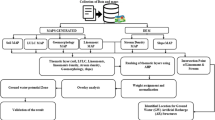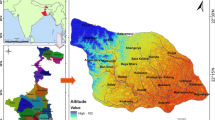Abstract
The accessibility of water resources is depleting everyday on a spatial and temporal scale, while water demand is expanding reliably. With this view, the investigation is an endeavour to identify the best locations appropriate for water conservation measures in West Midnapur, Purulia, and Bankura regions of West Bengal, India, using Geoinformatics approach. In this study, administrative boundaries have been considered to get the best locations for all water conservation measures. Then, these locations are shown district wise by considering administrative boundaries. In India, most of the funds are allocated based on administrative boundaries so it is necessary to suggest water conservation measures based on administrative boundaries. The Digital Elevation Model (DEM), Landsat 7 satellite imagery, and daily precipitation data of the year 2011 were used to get ready layers of the slope, and land use land cover. The runoff and runoff potential zones were determined using the Soil Conservation Service Curve Number (SCS-CN) method in the Geographic Information System (GIS) environment. The weights were assigned to thematic layers (slope and runoff coefficient) and ranks were given to these features; then, score was calculated to find out the Water Conservation Potential Index (WCPI). Thematic layers were integrated using ArcGIS software to generate water conservation potential maps for both surface water harvesting structures and groundwater recharge measures. Based on the values of WCPI, zones suitable for surface water harvesting structures and groundwater recharge measures were identified using slope, soil, drainage order, and rainfall as suitability criteria. The outcomes demonstrated that 479, 1884, 1400, 808, and 140 locations in all the three regions were suitable for percolation ponds, farm ponds, check dams, contour bunds, and contour trenching respectively. This research will be useful for policymakers to allocate government funds based on administrative boundaries.





Similar content being viewed by others
Availability of data and materials
All results are available upon request.
References
Agarwal D, Tongaria K, Pathak S, Ohri A, Jha M (2016) Soil erosion mapping of watershed in Mirzapur district using RUSLE model in GIS environment. IJSRTM 4(3):56–63. https://doi.org/10.18510/ijsrtm.2016.433
Ali DA, Deininger K, Monchuk D (2020) Using satellite imagery to assess impacts of soil and water conservation measures: Evidence from Ethiopia’s Tana-Beles watershed. Ecol Econ 169:106512. https://doi.org/10.1016/j.ecolecon.2019.106512
Ammar A, Riksen M, Ouessar M, Ritsema C (2016) Identification of suitable sites for rainwater harvesting structures in arid and semi-arid regions: A review. Int. Soil Water Conserv Res. 4(2):108–120. https://doi.org/10.1016/j.iswcr.2016.03.001
Arabameri A, Pradhan B, Pourghasemi HR, Rezaei K (2018) Identification of erosion-prone areas using different multi-criteria decision-making techniques and gis. Geomatics Nat Hazards Risk 9(1):1129–1155. https://doi.org/10.1080/19475705.2018.1513084
Boughton WC (1989) A review of the USDA SCS curve number method. Soil Res. 27(3):511–523
Chinnasamy P, Maheshwari B, Prathapar S (2015a) Understanding groundwater storage changes and recharge in Rajasthan, India through remote sensing. Water J 7(10):5547–5565
Chinnasamy P, Misra G, Shah T, Maheshwari B, Prathapar S (2015b) Evaluating the effectiveness of water infrastructures for increasing groundwater recharge and agricultural production–a case study of Gujarat, India. Agric Water Manag 158:179–188
Choi J, Engel BA, Chung HW (2002) Daily streamflow modelling and assessment based on the curve-number technique. Hydrol Process 16(16):3131–3150
Choudhari PP, Jadhav A (2016) Analysis Of Morphometric Parameters Of A Pavana River Basin, India Using Aster (Dem) Data and GIS. Int Multidiscip Res J 1:333–343
Choudhari PP, Nigam GK, Singh SK, Thakur S (2018) Morphometric based prioritization of watershed for groundwater potential of Mula river basin, Maharashtra, India. Geol Ecol Landscapes 2(4):256–267. https://doi.org/10.1080/24749508.2018.1452482
Congalton RG (1991) A review of assessing the accuracy of classifications of remotely sensed data. Remote Sens Environ 37(1):35–46
De Winnaar G, Jewitt GPW, Horan M (2007) A GIS-based approach for identifying potential runoff harvesting sites in the Thukela River basin, South Africa. Phy Chem Earth Parts A/B/C 32(15-18):1058–1067. https://doi.org/10.1016/j.pce.2007.07.009
Dev R, Bali M (2019) Evaluation of groundwater quality and its suitability for drinking and agricultural use in district Kangra of Himachal Pradesh, India. J Saudi Soc Agric Sci 18(4):462–468. https://doi.org/10.1016/j.jssas.2018.03.002
Dijk V, Renzullo LJ (2010) Water resource monitoring systems and the role of satellite observations. Hydrol Earth Syst Sci Discuss. 7:6305–6349
Durbude DG, Venkatesh B (2004) Site suitability analysis for soil and water conservation structures. J Indian Soc Remote Sens 32(4):399–405. https://doi.org/10.1007/BF03030865
FAO (1977) Guidelines for Watershed Management. FAO Conservation Guide No.1, FAO, Rome, p 293
FAO (1997) The state of food and agriculture, edition 16, printed in Itlay
Ghadimi S, Ketabchi H (2019) Possibility of cooperative management in groundwater resources using an evolutionary hydro-economic simulation-optimization model. J Hydrol 578:124094. https://doi.org/10.1016/j.jhydrol.2019
Hallema DW, Moussa R, Sun G, McNulty SG (2016) Surface storm flow prediction on hillslopes based on topography and hydrologic connectivity. Ecol Process. 5(1):13. https://doi.org/10.1186/s13717-016-0057-1
Hawkins RH (1998) Local sources for runoff curve numbers, In Proceedings of 11th Annual Symposium of the AHS, Tucson, AZ, USA, vol 2326
Ibrahim-Bathis K, Ahmed SA (2016) Geospatial technology for delineating groundwater potential zones in Doddahalla watershed of Chitradurga district, India. Egypt J Remote Sens Space Sci 19(2):223–234. https://doi.org/10.1016/j.ejrs.2016.06.002
IMSD (1995) Integrated mission for sustainable development technical guidelines. National Remote Sensing Agency, Department of Space, Government of India.
Jamali AA, Ghorbani Kalkhajeh R (2020) Spatial Modeling Considering valley’s Shape and Rural Satisfaction in Check Dams Site Selection and Water Harvesting in the Watershed. Water Resour Manag 34(10):3331–3344. https://doi.org/10.1007/s11269-020-02616-2
Jha MK, Chowdary VM, Kulkarni Y, Mal BC (2014) Rainwater harvesting planning using geospatial techniques and multicriteria decision analysis. Resour Conserv Recycl 83:96–111. https://doi.org/10.1016/j.resconrec.2013.12.003
Kadam AK, Kale SS, Pande NN, Pawar NJ, Sankhua RN (2012) Identifying potential rainwater harvesting sites of a semi-arid, basaltic region of Western India, using SCS-CN method. Water Resour Manag 26(9):2537–2554
Kahinda JM, Taigbenu AE, Sejamoholo BBP, Lillie ESB, Boroto RJ (2009) A GIS-based decision support system for rainwater harvesting (RHADESS). Phy Chem Earth Parts A/B/C 34:767–775. https://doi.org/10.1016/j.pce.2009.06.011
Kala V, Sunil DG, Assela P (2008) Assela Pathirana, Managing urban water supplies in developing countries – Climate change and water scarcity scenarios. Phy Chem Earth, Parts A/B/C 33(5):330–339. https://doi.org/10.1016/j.pce.2008.02.008
Kulkarni Y (2011) Evaluation of rainwater harvesting potential in Binpur blocks of West Midnapur district (unpublished doctoral thesis). Indian Institute of Technology, Kharagpur
Kumar MG, Agarwal AK, Bali R (2008) Delineation of potential sites for water harvesting structures using remote sensing and GIS. J Indian Soc Remote Sens. 36(4):323–334. https://doi.org/10.1007/s12524-008-0033-z
Magesh NS, Chandrasekar N, Soundranayagam JP (2012) Delineation of groundwater potential zones in Theni district, Tamil Nadu, using remote sensing, GIS and MIF techniques. Geosci Front 3(2):189–196. https://doi.org/10.1016/j.gsf.2011.10.007
Mahmoud SH, Alazba AA (2015) The potential of in situ rainwater harvesting in arid regions: developing a methodology to identify suitable areas using GIS-based decision support system. Arab J Geosci 8(7):5167–5179. https://doi.org/10.1007/s12517-014-1535-3
Mahmoud SH, Tang X (2015) Monitoring prospective sites for rainwater harvesting and stormwater management in the United Kingdom using a GIS-based decision support system. Environ Earth Sci. 73(12):8621–8638. https://doi.org/10.1007/s12665-015-4026-2
Malik A, Kumar A, Kandpal H (2019) Morphometric analysis and prioritization of sub-watersheds in a hilly watershed using weighted sum approach. Arab J Geosci 12(118). https://doi.org/10.1007/s12517-019-4310-7
Martins L, Pereira A, Oliveira A, Fernandes LFS, Pacheco FAL (2019) A new framework for the management and radiological protection of groundwater resources:The implementation of a Portuguese Action Plan for Radon in drinking water and impacts on human health. Water J. 11(4). https://doi.org/10.3390/w11040760
Mishra V, Tiwari AD, Aadhar S, Shah R, Xiao M, Pai DS, Lettenmaier D (2019) Drought and Famine in India, 1870–2016. Geophys Res Lett. 46(4):2075–2083. https://doi.org/10.1029/2018GL081477
Mugo GM, Odera PA (2019) Site selection for rainwater harvesting structures in Kiambu County-Kenya. Egypt J Remote Sens Space Sci. 22(2):155–164. https://doi.org/10.1016/j.ejrs.2018.05.003
Murthy K, Amminedu E, Rao V (2003) Integration of thematic maps through gis for identification of groundwater potential zones. J Indian Soc Remote Sens. 31(3):197–210
Onyelowe KC (2017) The menace of the Geo-Environmental hazard caused by gully erosion in Abia State, Nigeria. Environ Technol Innov 8:343–348. https://doi.org/10.1016/j.eti.2017.08.006
Padmavathy AS, Raj KG, Yogarajan N, Thangavel P, Chandrasekhar MG (1993) Checkdam site selection using GIS approach. Adv Space Res 13(11):123–127. https://doi.org/10.1016/0273-1177(93)90213-U
Pradhan B, Chaudhari A, Adinarayana J, Buchroithner MF (2012) Soil erosion assessment and its correlation with landslide events using remote sensing data and GIS:A case study at Penang Island, Malaysia. Environ Monit Assess 184(2):715–727. https://doi.org/10.1007/s10661-011-1996-8
Rajasekhar M, Gadhiraju SR, Kadam A, Bhagat V (2020) Identification of groundwater recharge-based potential rainwater harvesting sites for sustainable development of a semiarid region of southern India using geospatial, AHP, and SCS-CN approach. Arab J Geosci 13(2). https://doi.org/10.1007/s12517-019-4996-6
Rao S, Jugran DK (2020) Delineation of groundwater potential zones and zones of groundwater quality suitable for domestic puroses using remote sensing and GIS. Hydrol Sci J 48(5):821–833. https://doi.org/10.1623/hysj.48.5.821.51452
Rizeei HM, Pradhan B, Saharkhiz MA (2017) Surface runoff estimation and prediction regarding LULC and climate dynamics using coupled LTM, optimized ARIMA and distributed-GIS-based SCS-CN models at tropical region. In: Global civil engineering conference :1103-1126. Springer, Singapore
Rizeei HM, Saharkhiz MA, Pradhan B, Ahmad N (2016) Soil erosion prediction based on land cover dynamics at the Semenyih watershed in Malaysia using LTM and USLE models. Geocarto Int. 31(10):1158–1177. https://doi.org/10.1080/10106049.2015.1120354 Singh A
Rushema ME, Maniragaba A, Ndihokubwayo ML, Kulimushi MLC (2020) The Impact of Land Degradation on Agricultural Productivity in Nyabihu District-Rwanda, A Case Study of Rugera Sector. IJOEAR 6(7):49–63
Salih AA, Hamid AA (2017) Hydrological studies in the White Nile State in Sudan. Egypt J Remote Sens Space Sci 20:S31–S38
Shadeed S, Almasri M (2010) Application of GIS-based SCS-CN method in West Bank catchments, Palestine. Water Sci Eng 3(1):1–13. https://doi.org/10.3882/j.issn.1674-2370.2010.01.001
Shinde S, Choudhari PP, Popatkar B, Choudhari N (2020) Assessment of groundwater quality using GIS in Thane Municipal Corporation, Maharashtra, India. MESE:1–13. https://doi.org/10.1007/s40808-020-00906-7
Smith LC (1997) Satellite remote sensing of river inundation area, stage, and discharge: A review. Hydrological Process 11(10):1427–1439
Srinivasa Rao Y, Jugran DK (2003) Delineation of groundwater potential zones and zones of groundwater quality suitable for domestic purposes using remote sensing and GIS. Hydrol Sci J 48(5):821–833. https://doi.org/10.1623/hysj.48.5.821.51452
Strahler AN (1964) Quantitative geomorphology of drainage basins and channel networks. McGraw-Hill, New York
Subramanya K (2008) Engineering hydrology. McGraw-Hill, Educaion India, Private limited, New Delhi
Tayade AS, Vasantha S, Anusha S, Kumar R, Hemaprabha G (2020) Irrigation Water Use Efficiency and Water Productivity of Commercial Sugarcane Hybrids under Water-Limited Conditions. T ASABE 63(1):125–132 https://doi.org/10.13031/trans.13548
United States Soil Conservation Service (1986) Urban hydrology for small watersheds (No. 55). Engineering Division, Soil Conservation Service, US Department of Agriculture. https://tamug-ir.tdl.org/bitstream/handle/1969.3/24438/6545
Uwizeyimana D, Mureithi SM, Mvuyekure SM, Karuku G, Kironchi G (2019) Modelling surface runoff using the soil conservation service-curve number method in a drought prone agro-ecological zone in Rwanda. Int Soil Water Conserv Res. 7(1):9–17. https://doi.org/10.1016/j.iswcr.2018.12.001
Van Mullem JA, Garen D, Woodward D, Mockus V (2004) Hydrology National Engineering Handbook Chapter 11 Snowmelt Part 630. US Dept. of Agriculture Natural Resources Conservation Service, Washington, DC
Vema V, Sudheer KP, Chaubey I (2019) Fuzzy inference system for site suitability evaluation of water harvesting structures in rainfed regions. Agric Water Manag. 218:82–93. https://doi.org/10.1016/j.agwat.2019.03.028
Vema VK, Sudheer KP, Chaubey I (2020) Uncertainty of hydrologic simulation, and its impact on the design and the effectiveness of water conservation structures. Stoch Environ Res Risk Assess 34(7):973–991. https://doi.org/10.1007/s00477-020-01814-z
Yadav SK, Singh SK, Gupta M, Srivastava PK (2014) Morphometric analysis of upper tons basin from northern Foreland of Peninsular India using CARTOSAT satellite and GIS. Geocarto Int. 29(8):895–914
Acknowledgements
We thank the anonymous reviewers for their careful reading of our manuscript and their many insightful comments and suggestions.
Funding
Not received any grants from Government or Private Institutions for this work.
Author information
Authors and Affiliations
Contributions
All authors have equally contributed.
Corresponding author
Ethics declarations
Conflict of interests
The authors declare that they have no competing interests
Additional information
Responsible Editor: Biswajeet Pradhan
Rights and permissions
About this article
Cite this article
Kolekar, S.S., Mishra, A., Choudhari, P. et al. Identification of specific areas for water conservation measures using Geoinformatics approach. Arab J Geosci 14, 531 (2021). https://doi.org/10.1007/s12517-021-06721-3
Received:
Accepted:
Published:
DOI: https://doi.org/10.1007/s12517-021-06721-3




